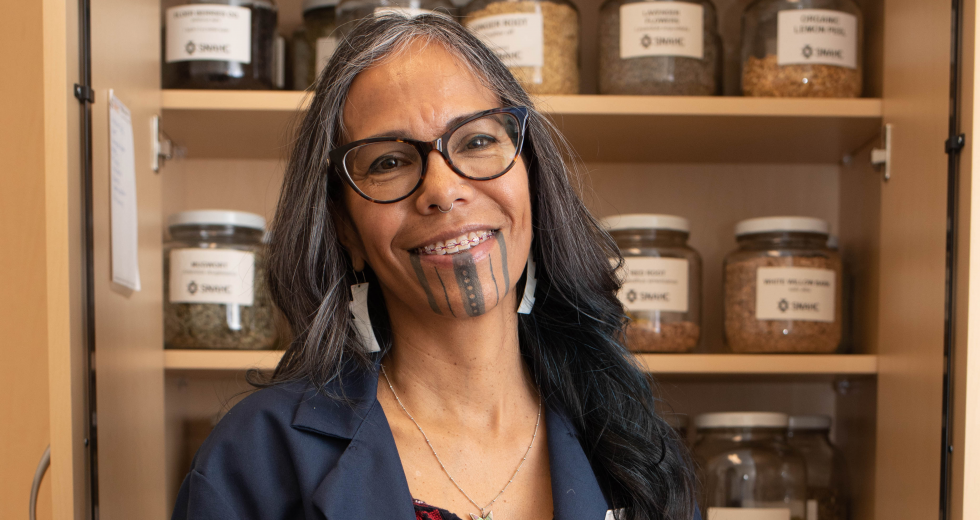From echinacea to valerian root, human beings have long relied on herbs as a source of wellness. “We’ve had a continued and never-ending relationship with botany and the plant world since the beginnings of us,” says Sage LaPena, certified medical herbalist with the Sacramento Native American Health Center. As the practitioner for the organization’s Healing Ways Program for the last three years, LaPena helps patients battling diabetes and other health woes get control of their conditions through a holistic approach that includes herbal supplementation, health education and sometimes a little gentle prodding.
“We’ve had a continued and never-ending relationship with botany and the plant world since the beginnings of us.”
Sage LaPena, Medical herbalist, Sacramento Native American Health Center
She serves a primarily Native American population, some of whom are housing challenged, and many of whom are diabetic. One in six Native Americans suffer from the disease, she says, compared to a little over one in 10 in the general American population. “It is a huge problem in Indian Country,” she explains. “So that’s a huge facet of the work I do here.”
LaPena is Nomtipom Wintu of Northern California and says she started learning about plant medicine “as a child working with a traditional person who was a California tribal ancestor and a well-known Indian doctor.” She grew up in the Sacramento area, attended El Camino High School and Sacramento City College, and went on to study at the California School of Herbal Studies in Sonoma County, where she is currently a rotating guest staff member. “I thought everybody had this information that was part of our culture,” she says. “I didn’t know how much had been stripped away from so many people.”
Typically, individuals who visit SNAHC are first seen by a primary care physician, and then referred to LaPena for her services as an option. “Someone with diabetes, for example, might possibly be given a compound of bitter melon, gymnema and cinnamon,” she says — herbs that can help lower blood sugar and reduce carbohydrate cravings. But everyone is different depending on their needs.
The Sacramento Native American Health Center in Midtown
Sacramento offers a range of programs and services across the
continuum of care. Plans to expand to South Sacramento are
currently in the works.

The patients she sees deal with a range of issues from anxiety and depression to homelessness, so getting them to take the herbs regularly can sometimes be an uphill battle. “Someone dealing with housing challenges would not find it as easy to brew tea from bulk tea,” she says. She’s developed a system that includes automatic follow-up appointments and phone calls to check in and make sure patients are staying on track.
Access to healthy food is also a major challenge for the people she serves. “When people are living in group housing or going to soup kitchens, much of the food available is filler food like pasta. And of course, starches are a huge factor in diabetes,” she says. Learning to grow your own food is one answer. “Even if you have a small porch, you can grow food in a five-gallon bucket,” she says. “Food sovereignty is at the forefront of Indian Country.”
Through urban plant walks in downtown and Midtown Sacramento, LaPena teaches participants about local native and non-native plant species, many of which are medicinal. “Some of the so-called weeds are some of the best plant medicines,” says LaPena. “Some important natives one can find downtown or in adjacent areas include black walnut, elderberry, willow, magnolia and mugwort.”
“We have set the bar high for other (Indian Health Service) clinics. I’m glad to set precedence of a higher standard of care in the clinical setting for all, but particularly for Native Americans.”
Sage LaPena, Medical herbalist, Sacramento Native American Health Center
The Healing Ways Program also holds community meals throughout the Sacramento area during the year. “We try to utilize our (memorandums of understanding) with our community partners and make the community meals as accessible as possible,” she says.
Her go-to plant? “Stinging nettles! They’re in the mint family. It’s very high in minerals, iron, calcium,” she explains. “It’s very good as an antihistamine, so you can take it in capsules or tea for your allergies. Nettle soup — so yummy.”
LaPena is excited as SNAHC prepares to open a new location in November 2022 in south Sacramento, and she prepares to hire an apprentice. “We have set the bar high for other (Indian Health Service) clinics. I’m glad to set precedence of a higher standard of care in the clinical setting for all, but particularly for Native Americans.”
–
Get all the stories in our annual salute to women in leadership delivered to your inbox: Subscribe to the Comstock’s newsletter today.
Recommended For You

Women in Leadership: Amber Hoiska
Our annual salute to extraordinary women breaking barriers and rising to the top
Amber Hoiska is breaking the glass ceiling of the male-dominated
roofing industry, and she wants more women to seize
the opportunities with her.

Women in Leadership: Nicole Elliott
Our annual salute to extraordinary women breaking barriers and rising to the top
As director of the California Department of Cannabis Control, Nicole Elliot leads 400 employees through what is essentially a testing ground for future legislation. She describes her regulatory work in the new industry as “a massive social experiment.”

Women in Leadership: Krista Bernasconi
Our annual salute to extraordinary women breaking barriers and rising to the top
From the corporate world to the nonprofit, entrepreneurship to mayorship, Krista Bernasconi is fueled by her passion for public service.

Women in Leadership: Preet Ahluwalla
Our annual salute to extraordinary women breaking barriers and rising to the top
The GNP Capital Partners owner shares what she’s learned about pivoting in business, juggling multiple leadership roles and uplifting the next generation of women entrepreneurs.

Women in Leadership: Estella Atekwana
Our annual salute to extraordinary women breaking barriers and rising to the top
Estella Atekwana surmounted language barriers, family pressures and more on her journey to become a pioneer of biogeophysics and dean of UC Davis’s largest college.



